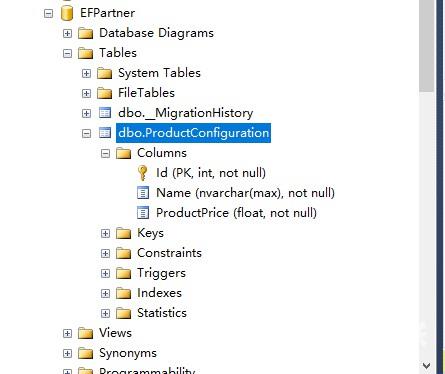在上一篇文章中讲了如何使用fluent API来创建数据表,不知道你有没有注意到一个问题。上面的OnModelCreating方法中,我们只配置了一个类Product,也许代码不是很多,但也不算很少,如果
在上一篇文章中讲了如何使用fluent API来创建数据表,不知道你有没有注意到一个问题。上面的OnModelCreating方法中,我们只配置了一个类Product,也许代码不是很多,但也不算很少,如果我们有1000个类怎么办?都写在这一个方法中肯定不好维护。EF提供了另一种方式来解决这个问题,那就是为每个实体类单独创建一个配置类。然后在OnModelCreating方法中调用这些配置伙伴类。
创建Product实体类:
using System;
using System.Collections.Generic;
using System.Linq;
using System.Text;
using System.Data.Entity.ModelConfiguration;
namespace EF配置伙伴.Model
{
public class Product
{
public int ProductNo { get; set; }
public string ProductName { get; set; }
public double ProductPrice { get; set; }
}
}
创建Product实体类的配置类:ProductMap,配置类需要继承自EntityTypeConfiguration泛型类,EntityTypeConfiguration位于System.Data.Entity.ModelConfiguration命名空间下,ProductMap类如下:
using EF配置伙伴.Model;
using System;
using System.Collections.Generic;
using System.Data.Entity.ModelConfiguration;
using System.Linq;
using System.Text;
namespace EF配置伙伴.EDM
{
public class ProductMap :EntityTypeConfiguration<Product>
{
public ProductMap()
{
// 设置生成的表名称
ToTable("ProductConfiguration");
// 设置生成表的主键
this.HasKey(p => p.ProductNo);
// 修改生成的列名
this.Property(p =>p.ProductNo).HasColumnName("Id");
this.Property(p => p.ProductName)
.IsRequired() // 设置 ProductName列是必须的
.HasColumnName("Name"); // 将ProductName映射到数据表的Name列
}
}
}
在数据上下文Context类的OnModelCreating()方法中调用:
using EF配置伙伴.EDM;
using EF配置伙伴.Model;
using System;
using System.Collections.Generic;
using System.Data.Entity;
using System.Linq;
using System.Text;
namespace EF配置伙伴.EFContext
{
public class Context:DbContext
{
public Context()
: base("DbConnection")
{ }
public DbSet<Product> Products { get; set; }
protected override void OnModelCreating(DbModelBuilder modelBuilder)
{
// 添加Product类的配置类
modelBuilder.Configurations.Add(new ProductMap());
base.OnModelCreating(modelBuilder);
}
}
}
查看数据库,可以看到符合我们的更改:

这种写法和使用modelBuilder是几乎一样的,只不过这种方法更好组织处理多个实体。你可以看到上面的语法和写jQuery的链式编程一样,这种方式的链式写法就叫Fluent API。
到此这篇关于Entity Framework使用配置伙伴创建数据库的文章就介绍到这了。希望对大家的学习有所帮助,也希望大家多多支持自由互联。
